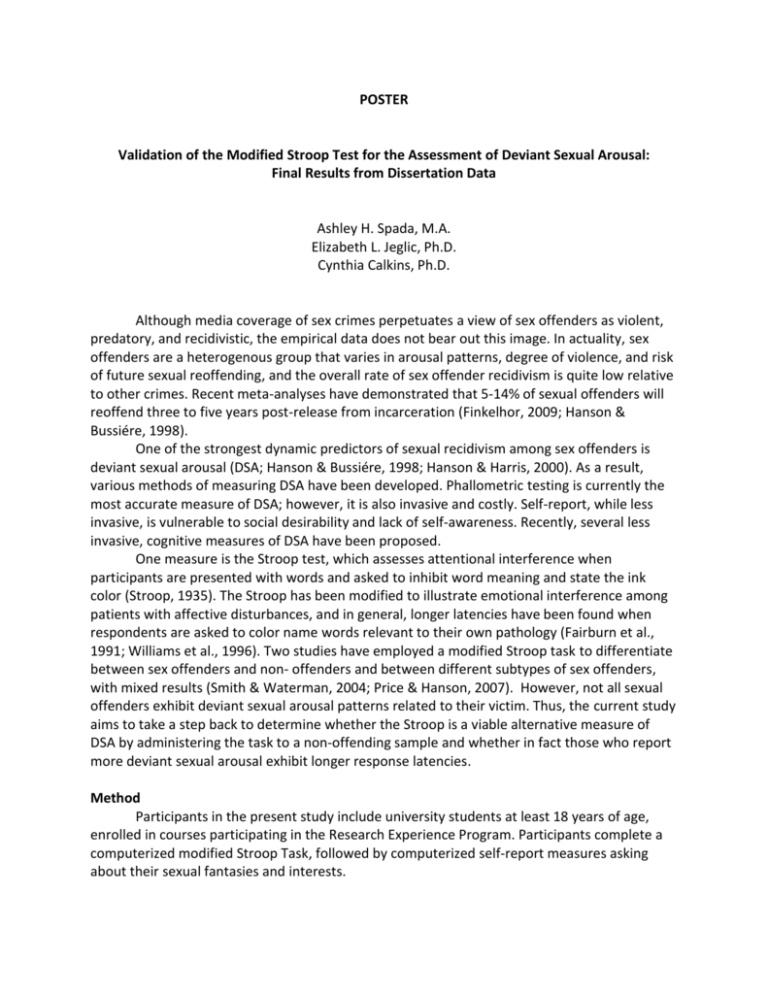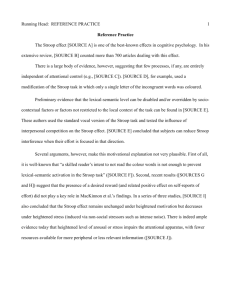
POSTER
Validation of the Modified Stroop Test for the Assessment of Deviant Sexual Arousal:
Final Results from Dissertation Data
Ashley H. Spada, M.A.
Elizabeth L. Jeglic, Ph.D.
Cynthia Calkins, Ph.D.
Although media coverage of sex crimes perpetuates a view of sex offenders as violent,
predatory, and recidivistic, the empirical data does not bear out this image. In actuality, sex
offenders are a heterogenous group that varies in arousal patterns, degree of violence, and risk
of future sexual reoffending, and the overall rate of sex offender recidivism is quite low relative
to other crimes. Recent meta-analyses have demonstrated that 5-14% of sexual offenders will
reoffend three to five years post-release from incarceration (Finkelhor, 2009; Hanson &
Bussiére, 1998).
One of the strongest dynamic predictors of sexual recidivism among sex offenders is
deviant sexual arousal (DSA; Hanson & Bussiére, 1998; Hanson & Harris, 2000). As a result,
various methods of measuring DSA have been developed. Phallometric testing is currently the
most accurate measure of DSA; however, it is also invasive and costly. Self-report, while less
invasive, is vulnerable to social desirability and lack of self-awareness. Recently, several less
invasive, cognitive measures of DSA have been proposed.
One measure is the Stroop test, which assesses attentional interference when
participants are presented with words and asked to inhibit word meaning and state the ink
color (Stroop, 1935). The Stroop has been modified to illustrate emotional interference among
patients with affective disturbances, and in general, longer latencies have been found when
respondents are asked to color name words relevant to their own pathology (Fairburn et al.,
1991; Williams et al., 1996). Two studies have employed a modified Stroop task to differentiate
between sex offenders and non- offenders and between different subtypes of sex offenders,
with mixed results (Smith & Waterman, 2004; Price & Hanson, 2007). However, not all sexual
offenders exhibit deviant sexual arousal patterns related to their victim. Thus, the current study
aims to take a step back to determine whether the Stroop is a viable alternative measure of
DSA by administering the task to a non-offending sample and whether in fact those who report
more deviant sexual arousal exhibit longer response latencies.
Method
Participants in the present study include university students at least 18 years of age,
enrolled in courses participating in the Research Experience Program. Participants complete a
computerized modified Stroop Task, followed by computerized self-report measures asking
about their sexual fantasies and interests.
Measures
The Emotional Stroop (Stroop, 1935).The Stroop measures interference effects when
participants are asked to state ink color while ignoring word meaning. In this study, a modified
version is being employed using sexually deviant, sexually normative (non-deviant), and neutral
words.
Sexual Interest Questionnaire (SIQ; Gray et al., 2003). The SIQ is a 93-item measure that
measures the frequency of various sexual fantasies on a 5 point Likert scale.
Preliminary Findings
Among the first 227 participants, the majority of the sample (97%) endorsed some form
of deviant sexual interest. The mean DSA score (out of 128) was 40.8. Preliminary results
reveled that mean response latency for deviant words was positively correlated with total
deviance score (r = .18, p = .0008), and that this pattern held for males but not females in the
sample. The proposed submission is a follow-up to preliminary data presented at the ATSA
conference in 2013 and will represent the final results from 800 respondents.
Implications & Future Directions
If a significant relationship between self-reported sexual arousal and Stroop
performance is found, the next step in this line of research will be a comparison of Stroop
performance to the best concurrent measure of DSA currently available, phallometric testing.
Clinicians are often asked to evaluate sexual offenders’ recidivism risk to inform decisions about
treatment, sentencing, and post-release supervision. However, sex offenders vary widely in
their risk of reoffending. Thus, accurate identification of those who are at highest risk is crucial,
so that policies, resources, and treatment may be allocated, based on risk level, to those
offenders for whom these interventions are most appropriate (Storey et al., 2012). Provided
that the Stroop is a valid measure of DSA, this research has far reaching implications for sex
offender risk assessment. Phallometry is invasive, expensive, and difficult to administer. The
Stroop, however, is non-invasive and would provide a faster and significantly less invasive
alternative for evaluating sexual recidivism risk.









